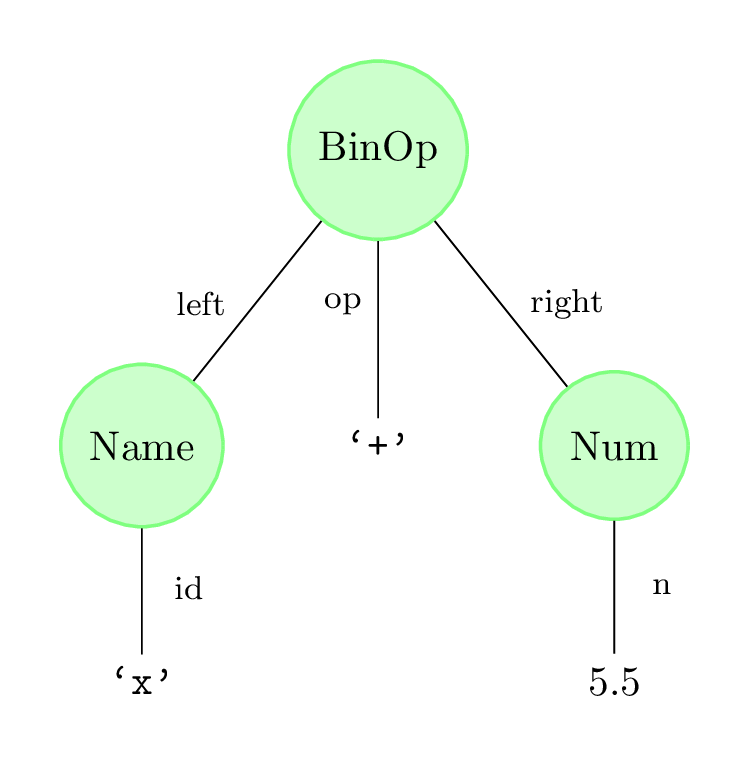In the last section, we began our study of representing code in a
recursive data structure called an abstract syntax tree. We
introduced three Python data types: Expr, an abstract class
representing an arbitrary type of expression, and its two subclasses
Num (representing numeric literals) and BinOp
(representing arithmetic operations like + and
*). In this section, we’re going to extend what we’ve
learned to introduce one new fundamental element of Python programs:
variables.
Variables and the
Name class
Consider the following Python expression: x + 5.5. This
is clearly an arithmetic expression, but its left operand,
x, is neither a numeric literal nor a nested arithmetic
expression. It is a variable, and so requires a new
Expr subclass, which we’ll call Name:
class Name(Expr):
"""A variable expression.
Instance Attributes:
- id: The variable name.
"""
id: str
def __init__(self, id_: str) -> None:
"""Initialize a new variable expression."""
self.id = id_With this class in hand, here is how we can represent the expression
x + 5.5:

# x + 5.5
BinOp(Name('x'), '+', Num(5.5))But we shouldn’t just be satisfied with representing this expression—how do we evaluate it?
Evaluating variables by dictionary lookup
Let’s draw inspiration from the Python interpreter. Suppose we type the following into the Python console:
>>> x + 5.5How does the Python interpreter compute the value of this expression? You might be thinking one of two things:
xhasn’t been defined yet, so we’d get aNameError!- Or, it depends on what value
xwas assigned to earlier in the console.
Both of these thoughts rely on the same underlying behaviour when
evaluating variables: the Python interpreter keeps track of what values
variables have been assigned to, and then looks up a variable’s current
value to evaluate it. Abstractly, this requires a mapping
between variable names and values, and so it is perhaps unsurprising
that the Python interpreter uses a dict to keep track of
this
data. The real story is more complex. Python has two
built-in functions, globals and locals, and
each return separate dictionaries. The former returns the “global
variable” dictionary, containing variables that have been defined in the
console or at the top-level of the current Python module. The latter
returns the “local variable” dictionary, which contains the variables in
the local scope wherever it is called (most commonly, inside the body of
a function). We call this dictionary the variable
environment, and call each key-value pair in the environment a
binding between a variable and its current value.
We’ll adapt this idea to modify our abstract syntax tree
implementation. This is a fairly large change: we need to modify our
Expr.evaluate method header so that it takes an additional
argument, env, which contains all of the current variable
bindings that can be used when evaluating the expression. Here is how we
could update all three of Expr, Num, and
BinOp to use this new method form:
class Expr:
def evaluate(self, env: dict[str, Any]) -> Any:
"""Evaluate this statement with the given environment.
This should have the same effect as evaluating the statement by the
real Python interpreter.
"""
raise NotImplementedError
class Num(Expr):
def evaluate(self, env: dict[str, Any]) -> Any:
"""..."""
return self.n # Simply return the value itself!
class BinOp(Expr):
def evaluate(self, env: dict[str, Any]) -> Any:
"""..."""
left_val = self.left.evaluate(env)
right_val = self.right.evaluate(env)
if self.op == '+':
return left_val + right_val
elif self.op == '*':
return left_val * right_val
else:
raise ValueError(f'Invalid operator {self.op}')Nothing has changed much: we’ve added the new parameter
env, and are passing it into the recursive calls in
BinOp.evaluate). But now with this new parameter, we can
implement Name.evaluate quite easily.
class Name:
def evaluate(self, env: dict[str, Any]) -> Any:
"""Return the *value* of this expression.
The returned value should be the result of how this expression would be
evaluated by the Python interpreter.
The name should be looked up in the `env` argument to this method.
Raise a NameError if the name is not found.
"""
if self.id in env:
return env[self.id]
else:
raise NameError(f"name '{self.id}' is not defined")Here are two examples of using this method:
>>> expr = Name('x')
>>> expr.evaluate({'x': 10})
10
>>> binop = BinOp(expr, '+', Num(5.5))
>>> binop.evaluate({'x': 100})
105.5This seems a bit too easy, and you might be wondering: just where do
these environments come from? Our two examples used arbitrarily-chosen
numbers for x, but we certainly don’t expect (or want) the
Python interpreter to generate random variable bindings. To understand
how these environments are defined, we’ll need to broaden our
implementation of abstract syntax trees to introduce different kinds of
statements, such as the assignment statements that determine
the value of the current environment. Stay tuned for this in the next
section!